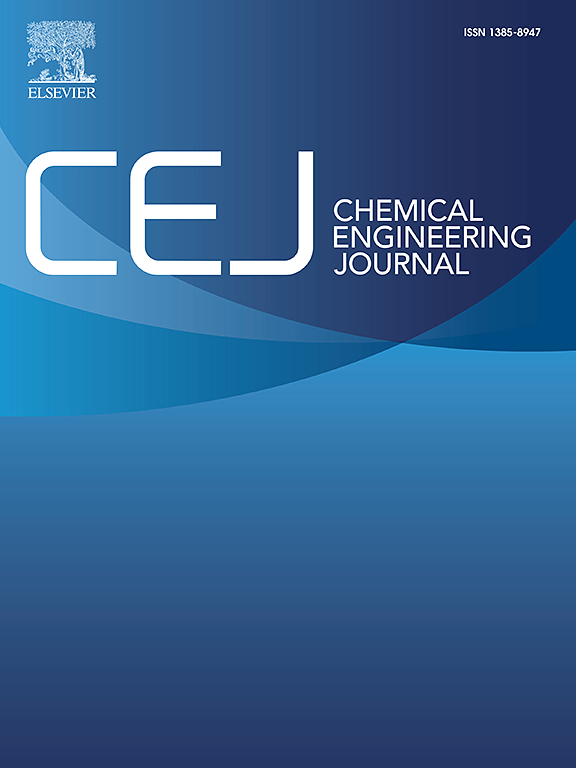Carbon microsphere-modified MXene: A high-efficiency hybrid flame retardant for simultaneously enhancing fire resistance, smoke suppression and thermal conductivity in poly (L-lactic acid)
IF 13.2
1区 工程技术
Q1 ENGINEERING, CHEMICAL
引用次数: 0
Abstract
Two-dimensional layered MXene nanosheets represent a promising environmentally friendly and efficient flame retardant. However, MXene tends to aggregate readily in polymer matrices, which compromises the mechanical and flame-retardant properties of the resulting composites. Carbon microspheres (CMSs), with their diverse surface-active functional groups, provide an effective solution to address this challenge. Furthermore, the carbon-rich CMSs enhance the flame retardancy of composites through their catalytic carbonization effect. In this work, we achieve for the first time the uniform loading of CMSs onto MXene nanosheets via electrostatic self-assembly. This innovative strategy effectively resolves the dispersion challenges of MXene in polymer matrices and enables its incorporation into poly (l-lactic acid) (PLA) systems. Remarkably, with only 5 wt% MXene/CMSs loading, the PLA/MXene/CMSs composite exhibited improved mechanical properties, and the thermal conductivity of the PLA composite was increased to 0.31 W∙m−1∙K−1, which was 47.6% higher than that of Neat PLA. In addition, the limiting oxygen index (LOI) increased to 26.6%, achieving a V-0 rating in the UL-94 vertical burning test. Compared to neat PLA, the composite demonstrated reductions of 28.1% and 15% in the peak heat release rate (pHRR) and total heat release (THR), respectively. Notably, the total smoke release (TSR) decreased significantly by 70.4% relative to Neat PLA. Additionally, a more stable and compact char layer formed during combustion. This enhancement primarily originates from the markedly improved dispersion of flame retardants in the PLA matrix, the catalytic carbonization effect mediated by transition metal Ti in MXene, and the efficient carbonization capability of CMSs. This work provides an advanced and eco-friendly solution to address the trade-off between MXene aggregation in polymers, high flame-retardant efficiency, smoke suppression, thermal conductivity and mechanical performance.

碳微球改性MXene:一种同时增强聚l -乳酸阻燃性、抑烟性和导热性的高效杂化阻燃剂
二维层状MXene纳米片是一种很有前途的环保高效阻燃剂。然而,MXene倾向于在聚合物基体中容易聚集,这损害了所得复合材料的机械和阻燃性能。碳微球(cms)具有多种表面活性官能团,为解决这一挑战提供了有效的解决方案。此外,富碳cms通过其催化碳化作用增强了复合材料的阻燃性。在这项工作中,我们首次通过静电自组装实现了cms在MXene纳米片上的均匀加载。这一创新策略有效地解决了MXene在聚合物基质中的分散挑战,并使其能够融入聚乳酸(PLA)体系。值得注意的是,当MXene/ cms的负载量仅为5 wt%时,PLA/MXene/ cms复合材料的力学性能得到了改善,PLA复合材料的导热系数提高到0.31 W∙m−1∙K−1,比纯PLA提高了47.6%。此外,极限氧指数(LOI)提高到26.6%,在UL-94垂直燃烧试验中达到V-0等级。与纯PLA相比,复合材料的峰值放热率(pHRR)和总放热率(THR)分别降低了28.1%和15%。总烟雾释放量(TSR)较纯PLA显著降低70.4%。此外,在燃烧过程中形成了更稳定和致密的炭层。这种增强主要源于阻燃剂在PLA基体中的分散性显著提高、过渡金属Ti在MXene中的催化碳化作用以及cms的高效碳化能力。这项工作为解决聚合物中MXene聚集、高阻燃效率、抑烟、导热性和机械性能之间的权衡提供了一种先进且环保的解决方案。
本文章由计算机程序翻译,如有差异,请以英文原文为准。
求助全文
约1分钟内获得全文
求助全文
来源期刊

Chemical Engineering Journal
工程技术-工程:化工
CiteScore
21.70
自引率
9.30%
发文量
6781
审稿时长
2.4 months
期刊介绍:
The Chemical Engineering Journal is an international research journal that invites contributions of original and novel fundamental research. It aims to provide an international platform for presenting original fundamental research, interpretative reviews, and discussions on new developments in chemical engineering. The journal welcomes papers that describe novel theory and its practical application, as well as those that demonstrate the transfer of techniques from other disciplines. It also welcomes reports on carefully conducted experimental work that is soundly interpreted. The main focus of the journal is on original and rigorous research results that have broad significance. The Catalysis section within the Chemical Engineering Journal focuses specifically on Experimental and Theoretical studies in the fields of heterogeneous catalysis, molecular catalysis, and biocatalysis. These studies have industrial impact on various sectors such as chemicals, energy, materials, foods, healthcare, and environmental protection.
 求助内容:
求助内容: 应助结果提醒方式:
应助结果提醒方式:


